Replaces
2003 GMC Sierra 1500 V8 5.3L with 12.99 in. (330mm) Diameter Rear Rotors with 6 Lug Wheels with Single Piston Rear Calipers Front & Rear Ceramic Performance Brake Pad & Rotor Kit TRQ Performance BKA14047
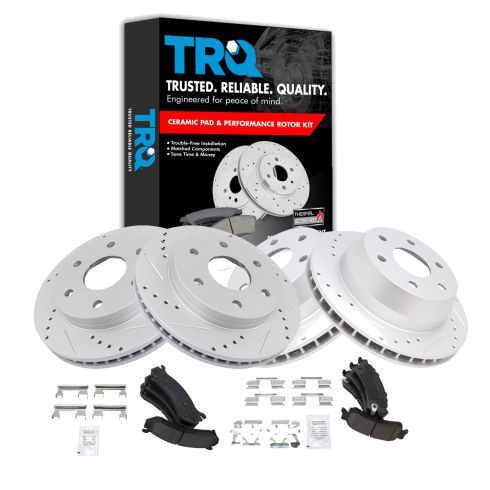


BKA14047
In Stock
This part doesn’t fit a . Select from parts that fit.
Specify your vehicle's year, make and model to guarantee fit.
Orders must be placed by 2pm ET

You may also like
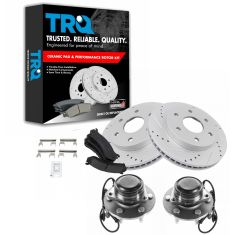
Ceramic Performance Brake Pad & Rotor Kit with Wheel Bearings
$264.95
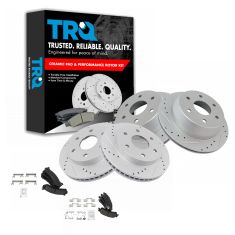
Ceramic Performance Brake Pad & Rotor Kit
$274.95
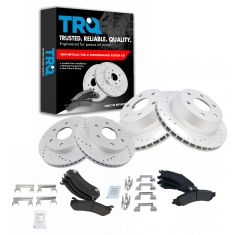
Semi-Metallic Performance Brake Pad & Rotor Kit
$294.95
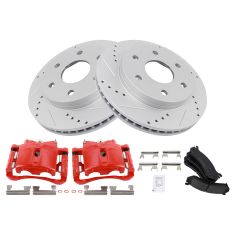
Ceramic 4 Piece Performance Brake Pad & Rotor Kit with Performance Calipers
$299.95
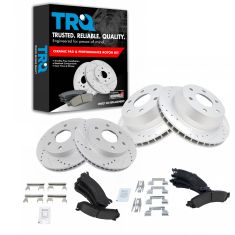
Ceramic Performance Brake Pad & Rotor Kit
$304.95
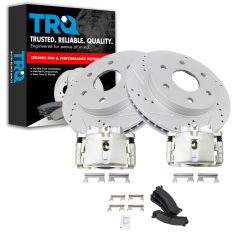
Ceramic Performance Brake Pad & Rotor Kit with Calipers
$304.95
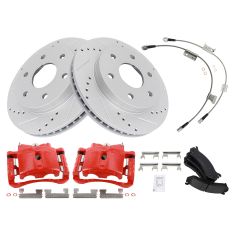
Ceramic 6 Piece Performance Brake Pad & Rotor Kit with Performance Calipers & Hoses
$334.95
Part Details
- Brake Pad Bonding Type: Premium Posi
- Wheel Lug Count: 6 Lug
- Rear Brake Rotor Venting Type: Vented
- Brake Pad Friction Material: Ceramic
- Front Brake Rotor Diameter: 12.01 in. (305mm)
- Brake Rotor Coating: Premium G-Coated
- Front Brake Rotor Venting Type: Vented
- Rear Brake Rotor Diameter: 12.99 in. (330mm)
- Surface Type: Slotted X Drilled
-
Kit Includes:
(1) Front Ceramic Brake Pad Set with Contact Point Grease & Hardware
(1) Rear Ceramic Brake Pad Set with Contact Point Grease & Hardware
(2) Front G-Coated Performance Brake Rotors
(2) Rear G-Coated Performance Brake Rotors - Grade Type: Performance
- Product Line: Performance
Specification
- with 6 Lug Wheels
- Front & Rear
- with Single Piston Rear Calipers
- V8 5.3L
Product Features
Item Condition:
New
Attention California Customers:
![]() WARNING: This product can expose you to chemicals including Lead and Lead Compounds, which are known to the State of California to cause cancer, and birth defects or other reproductive harm. For more information, go to www.P65Warnings.ca.gov.
WARNING: This product can expose you to chemicals including Lead and Lead Compounds, which are known to the State of California to cause cancer, and birth defects or other reproductive harm. For more information, go to www.P65Warnings.ca.gov.
Lifetime Warranty
This item is backed by our limited lifetime warranty. In the event that this item should fail due to manufacturing defects during intended use, we will replace the part free of charge. This warranty covers the cost of the part only.
FREE Shipping is standard on orders shipped to the lower 48 States (Contiguous United States). Standard shipping charges apply to Hawaii and Alaska.
Shipping is not available to a P.O. Box, APO/FPO/DPO addresses, US Territories, or Canada for this item.
Expedited is available on checkout to the United States, excluding Alaska, Hawaii.
Final shipping costs are available at checkout.




Created on:
Tools used
- Loosen the lug nut covers with a 22mm socket Pry off the center cap with a flat blade screwdriver Loosen the lug nuts with the vehicle on the ground Raise the vehicle with a floor jack Secure the vehicle on jack stands Remove the lug nuts Pull off the wheel
- Check the thickness of the brake pads Check the brake pad wear indicator
- Remove T55 Torx bolts from the brake caliper with a T55 Torx bit and ratchet Use either a C-clamp to squeeze the rotor or a screwdriver to pry the brake caliper off Pry the brake pads off with a flat blade screwdriver Remove the two 18mm bolts from the caliper bracket Slide the rotor off
- Apply brake cleaner to either side of the rotor Apply brake grease to either end of your brake pads Use a wire brush to clean up the brake slides on the caliper bracket
- Push the rotor back into place Twist on a lug nut Put the caliper back into place and tighten the two 18mm bolts Torque the 18mm bolts to 75 ft/lbs Push the brake pads into place, using a hammer if necessary Using an old brake pad, put it on to the caliper pistons and tighten it in with the C-Clamp Grease up the caliper bolts Put the caliper back into place Slide the slide bolts back in Torque the bolts to 30 ft/lbs
- Slide the wheel into place Start the lug nuts by hand Tighten the lug nuts preliminarily Lower the vehicle to the ground Tighten the lug nuts to 100 ft/lbs in a crossing or star pattern Reattach the hubcap and tighten the caps
- Pump your brakes repeatedly until they feel firm Test your brakes at 5 miles per hour and then 10 miles per hour Road test the vehicle
Brought to you by 1AAuto.com, your source for quality replacement parts and the best service on the Internet.
Hi, I'm Don from 1A Auto. I hope this how-to video helps you out, and the next time you need a part for your vehicle, think of 1AAuto.com. Thanks.
In this video, we're going to show you how to replace the brakes on this 2002 Chevy Suburban. The items you'll need for this include a new brake pad and rotor kit from 1AAuto.com, an 18mm and 22mm socket and ratchet, a piece of pipe for extra leverage, a T55 Torx bit, a large C-clamp, a torque wrench, a wire brush, jack and jack stands, brake cleaner, and brake grease.
You want to just loosen up these 22mm caps, and then pull the hubcap free. Then you want to loosen these lug nuts while the vehicle's on the ground, then raise the vehicle and remove them the rest of the way, unless you have air powered tools, then you can do it while it's in the air, and then just remove the wheel. You want to check for any deep groves in your rotor. You want to check in here for the life of your brake pads and over here for the life of the other one. You can see ours is actually in decent shape.
There's two T55 Torx bolts that you need to remove. We'll fast forward as we use a T55 Torx bit and a ratchet to remove those. Then, using a large C-clamp, just put it back behind the caliper here, and the other part right here on the brake pad, and just twist this in. This is going to push your caliper piston in and make it easier to pull the caliper off. Just remove the C-clamp and lift your caliper up and off and set it aside. Using a flat blade screwdriver, just pry out your brake pad. Sometimes the brake pads can be stuck in there. Use a flat blade screwdriver and a hammer to pry it free. You want to remove these two 18mm bolts on your caliper bracket.
You can see we use a piece of pipe for some extra leverage, here. We'll just fast forward as he breaks the other one free and removes both of these bolts. Now, slide the rotor off. On the left is the old rotor and brake pads, on the right are the new ones from 1A Auto. You can see they're identical and they'll fit exactly the same.
Spray your new rotor with brake cleaner and just wipe it down. Do the same thing to the back. Now, apply brake grease to the tabs on either end of your brake pads. Using your wire brush, just clean up those brake slides on your caliper bracket. Push your rotor back into place and then twist on a lug nut. This will hold the rotor in place. Turn the wheel and put the caliper bracket back in to place. Replace those two 18mm bolts. We'll fast forward as Don does this and tightens both of those up. Torque both of these to 75 foot-pounds.
Push your new brake pads into place. Use a hammer if necessary to lightly tap that into place. Using an old brake pad, just put it onto the caliper pistons and then tighten it in with your C-clamp. This will just push those pistons in the rest of the way. Grease up your caliper bolts. Out the caliper back into place and slide those slide bolts back in. We'll just fast forward as Don tightens those up. You'll want to tighten these to about 30 foot-pounds.
Now, replace your wheel and then replace those lug nuts and tighten them preliminarily, lower the vehicle, and tighten them the rest of the way. Torque the lug nuts in a crossing pattern to 100 foot-pounds. Replace the hubcap and tighten up those caps. After doing work on your brakes, you want to pump the brake pedal until it firms up and then try a stop test from five miles per hour and ten miles per hour, and you're all set.
We hope this video helps you out. Brought to you by www.1AAuto.com, your source for quality replacement parts and the best service on the Internet. Please feel free to call us toll-free, 888-844-3393. We're the company that's here for you on the Internet and in person.
Tools used
- Loosen the lug nut covers with a 22mm socket Pull off the center cap Loosen the lug nuts with the vehicle on the ground Raise the vehicle with a floor jack Secure the vehicle on jack stands Remove the lug nuts Pull off the wheel
- Check for gouges on both sides of the rotor Check the thickness of the brake pads
- Remove the two 12mm bolts from the brake caliper Use a large C-clamp to press in the brake caliper piston Pull the caliper aside Pry the brake pads off with a flat blade screwdriver
- Apply brake grease to the tabs of the new brake pads Put an old pad in the caliper Use a large C-clamp and the old pad to push the pistons further back Install the new brake pads into the bracket Put the caliper on Thread the two 12mm bolts by hand Tighten bolts to 30 foot-pounds of torque
- Slide the wheel into place Start the lug nuts by hand Tighten the lug nuts preliminarily Lower the vehicle to the ground Tighten the lug nuts to 100 foot-pounds in a crossing or star pattern Reattach the center cap Tighten the lug nut covers
- Pump your brakes repeatedly until they feel firm Test your brakes at 5 miles per hour and then 10 miles per hour Road test the vehicle
Brought to you by 1AAuto.com, your source for quality replacement parts and the best service on the Internet.
Hi, I'm Don from 1A Auto. I hope this how-to video helps you out, and next time you need parts for your vehicle, think of 1AAuto.com. Thanks.
In this video, we're going to show you how to replace the rear brake pads on this 2002 Chevy Suburban. We show you on the passenger side, but the driver's side is the same procedure. The items you'll need are new brake pads from 1AAuto.com, 12 and 22 mm socket and ratchet, flat blade screwdriver, large C-clamp, torque wrench, and jack and jack stands.
Start off by loosening up these lug nut covers and we'll fast forward as Don does this. Once those are all loosened up, you can pull the hubcap free. Now, you want to loosen the lug nuts preliminarily, raise the vehicle, and remove them the rest of the way, unless you have air powered tools. Then, you can do it while it's up in the air.
To inspect your brakes, run your finger along the rotor, check for any deep grooves. You can look in here for the life of this brake pad, and then, through here for the life of the other brake pad.
Now, remove these two 12mm bolts and we'll fast forward as Don does that. Use a large C-clamp. You put it on this end on the back of the caliper and on this brake pad and just twist it in. This is going to push the caliper piston in and make it easier to pull the caliper up and off. Remove the large C-clamp, pull the caliper free, and set it aside. Pry out the brake pads.
Take your new brake pads and apply brake grease to the tabs on either end of the brake pads. You want to reset the pistons in your caliper so put an old brake pad in there and just twist the C-clamp and it'll push those pistons back in. Push your new brake pads into place, and then, put your caliper back down into place and replace those two 12 mm bolts. We'll fast forward as Don does this and tightens them up. You want to tighten these to about 30 foot-pounds.
Put your wheel back into place and then replace your lug nuts and tighten them preliminarily. We'll fast forward as Don does this. Lower the vehicle and torque the lug nuts to 100 foot-pounds in a crossing pattern. Replace that hubcap and tighten up each of your lug nut covers. Before taking the vehicle out on the road you want to pump the brake pedal until it firms up and then do a stopping test from 5 miles per hour and then 10 miles per hour and you're all set.
We hope this video helps you out. Brought to you by www.1AAuto.com, your source for quality replacement parts and the best service on the Internet. Please feel free to call us toll-free, 888-844-3393. We're the company that's here for you on the Internet and in person.
Tools used
- Loosen the lug nut covers with a 22mm socket Pry off the center cap with a flat blade screwdriver Loosen the lug nuts with the vehicle on the ground Raise the vehicle with a floor jack Secure the vehicle on jack stands Remove the lug nuts Pull off the wheel
- Remove the 18mm bolts from the brake caliper Pry the brake pads into the caliper with a flat blade screwdriver to push in the pistons Pull the caliper aside Pry the brake pads off with a flat blade screwdriver Remove the brake pad slides
- Spray the 21mm bolts with penetrating oil if rusted Remove the 21mm bolts from the brake caliper bracket Pull off the brake caliper bracket Pull the rotor off If the rotor will not come off, thread the lug nuts and strike the hub area of the rotor with the ball end of a ball peen hammer
- Clean the rotor with brake parts cleaner Clean the brake pad slides with a wire brush Apply grease to the caliper slides Apply grease to the brake pad tabs Clip the brake pad slides to the caliper bracket Put an old pad in the caliper Use a large C-clamp and the old pad to push the pistons back
- Slide the rotor on Thread on one lug nut to hold the rotor in place Put the bracket back into place Start the bolts by hand Tighten the bolts to 100 foot-pounds of torque
- Install the new brake pads into the bracket Put the caliper on Thread the bolts by hand Tighten the bolts to 100 foot-pounds
- Slide the wheel into place Start the lug nuts by hand Tighten the lug nuts preliminarily Lower the vehicle to the ground Tighten the lug nuts to 100 foot-pounds in a crossing or star pattern Reattach the center cap Tighten the lug nut covers with a 22mm socket
- Pump your brakes repeatedly until they feel firm Test your brakes at 5 miles per hour and then 10 miles per hour Road test the vehicle
Brought to you by 1AAuto.com, your source for quality replacement parts and the best service on the Internet.
Hi, I'm Mike from 1A Auto. I hope this how-to video helps you out, and next time you need parts for your vehicle, think of 1AAuto.com. Thanks.
In this video, we're going to show you how to replace the front brakes on this 2005 GMC Savana 2500. It's a similar process on the Chevy Express. The items you'll need for this is a new break set from 1A Auto, 18mm, 21mm, 22mm socket and ratchet, a breaker bar and a piece of pipe for leverage, a flat blade screwdriver, penetrating oil, a hammer, large C-clamp, white grease, torque wrench, and jack and jack stands.
Start off by removing the wheel cover or whatever wheel trim you might have. This one has a chrome one. Pull that off, and then just use your socket and pull or loosen the lug nut covers. Pull the center cap off. If you don't have the benefit of air tools, you want to loosen the lug nuts with the vehicle on the ground, then jack up and secure the vehicle. Then remove the lug nuts, wheel, and tire.
Turn the wheel so that you can get to the brake. On the back of the caliper, there's two 18mm bolts. You just want to remove these. It can be a little difficult, so it helps to use a piece of pipe for extra leverage. We're just going to fast forward as he removes this.
The next step, you want to use a flat blade screwdriver to just pry the brake pads away from the caliper, and it will allow you to pry off that caliper. Just keep using the flat blade screwdriver, top and the bottom, you could see he's just going back and forth until, eventually, it will come off. You just want to set that aside.
Now, using the flat blade screwdriver, you just want to pry out your brake pads. Now on some vehicles, it's going to be more difficult than on others. It depends on the condition of the brakes. In this case, it takes just a little effort, and if you have to, you can use a hammer just be careful not to damage or bend anything. We're just going to fast-forward a little bit as he removes those brake pad slides.
There are two 21mm bolts back here that hold on this caliper bracket. Ours are a little rusted, so we spray them with some penetrating oil first, just to loosen them up and let that sit for a second. Then, using a breaker bar, and, actually, a piece of pipe for extra leverage, we just remove those bolts, and we're just fast-forwarding here as he does that. When you remove those bolts, the caliper bracket will come right off.
Now, you just want to take a hammer and hammer the back of that rotor. Just keep turning it and hammering the back of it, and it's going to come off. With the old rotor; the new rotor. New pads; same size. With this caliper guide, you can replace these boots . If they're torn, you pull them out and you push them in. The most important thing about the brakes here, what we found was the pedal was soft, it didn't feel like they should, and you'll notice that when these were sliding or weren't sliding and getting stuck on this corroded brake slide hardware, you know it's the new parts, allow the pad to slide just it should when they're new.
Now we're just cleaning up the new rotor real quick. What you want to do is you want to take some white grease and just put it on the clips of these new brake pads. Then, using a flat blade screwdriver, just scrape some of the corrosion on that caliper bracket. This will just help those slides to clip back on. Now, what you want to do is just clip those slides on, and as Don was saying: "They make a difference." New ones are definitely worth it and 1A Auto does sell these. This just clips right into place. We'll just push them down.
Now, what you want to do is just reset the pistons in this caliper. What you want to do is take one of your brake pads. If you're changing them, you want to use one of the old ones, and you want to lay it across these two pistons. Then, using a large C-clamp, as you tighten the clamp, that paddle push those pistons back in and reset them, as you can see here. Now they're reset.
Now we're just going to put on our brand new rotor, and once you get it into place, you just want to put one of those lug nuts on, and it will just hold it into place. We put the rest of the brakes together. Now you can put your caliper bracket back on, and, to place those bolts, you want to just do them first by hand. Then, once you get them lined up and both them in place, you can use a socket and ratchet to tighten them the rest of the way. Now you want to just torque those bolts to 100 foot-pounds.
Now you can put your brake pads back in. Now, for these caliper pens, what you want to do is you want to clean them off a little bit, and then put some white grease on them, this will help them so that they slide easier.
What you want to do, pull down your caliper and just fit it into place. Now you can see up here, you want that little gasket there to go in and you can slide your bolts back in. We'll fast-forward here as he tightens those up with a socket and ratchet. Torque these bolts to 100 foot-pounds. We're just going to fast-forward here as you remove that nut, put the wheel into place, and you just want to replace all those nuts and tighten them in a crossing pattern.
Again, if you don't have air tools, you just want to lower the vehicle and tighten those the rest of the way on the ground. Then you want to torque those lug nuts to 100 foot-pounds. Before actually driving the vehicle, you want to pump the brake until they're firm, and then you want to do a test, stopping from 5 mph then 10 mph.
We hope this video helps you out. Brought to you by www.1AAuto.com, your source for quality replacement parts and the best service on the Internet. Please feel free to call us toll-free, 888-844-3393. We're the company that's here for you on the Internet and in person.
Tools used
- Loosen the 22mm caps on the hubcap with the vehicle on the ground Pull the hubcap free Raise the vehicle with a floor jack Secure the vehicle on jack stands Remove the lug nuts Pull off the wheel
- Turn the rotor by hand or turn the steering wheel to turn the rotor Check the thickness of the brake pads Check the brake pad wear indicator Check for gouges on both sides of the rotor
- Remove T55 Torx bolts from the brake caliper with a T55 Torx bit and ratchet Use either a C-clamp to squeeze the rotor or a screwdriver to pry the brake caliper off Pry the brake pads off with a flat blade screwdriver
- Apply brake grease to either side of your brake pads Push the brake pads into place, using a hammer if necessary Using an old brake pad put it on to the caliper pistons and tighten it in with the C-Clamp Grease up the caliper bolts
- Put the caliper back into place Slide the slide bolts back in Tighten the slide bolts to 30 ft/lbs
- Slide the wheel into place Start the lug nuts by hand Tighten the lug nuts preliminarily Lower the vehicle to the ground Tighten the lug nuts to 100 ft/lbs in a crossing or star pattern Reattach the hubcap and tighten the caps
- Pump your brakes repeatedly until they feel firm Test your brakes at 5 miles per hour and then 10 miles per hour Road test the vehicle
Brought to you by 1AAuto.com, your source for quality replacement parts and the best service on the Internet.
Hi, I'm Don from 1A Auto. I hope this how-to video helps you out, and the next time you need a part for your vehicle, think of 1AAuto.com. Thanks.
In this video, we're going to show you how to replace the brake pads on this 2002 Chevy Suburban. The items you'll need for this include new brake pads from 1AAuto.com, a 22mm socket and ratchet with a piece of pipe for extra leverage, a T55 Torx bit, a large C-clamp, a torque wrench, jack and jack stands, and brake grease.
You want to just loosen up these 22mm caps, and then pull the hubcap free. Then you want to loosen these lug nuts while the vehicle's on the ground, then raise the vehicle and remove them the rest of the way, unless you have air powered tools, then you can do it while it's in the air, and then just remove the wheel. Check your rotors. If there's any deep grooves or rust you'll want to replace the rotors as well. You can also check your pad life. You can see ours are actually in good shape, but we're going to show you how to replace them anyways.
There's two T55 Torx bolts that you need to remove. We'll fast forward as we use a T55 Torx bit and a ratchet to remove those. Then, using a large C-clamp, just put it back behind the caliper here, and the other part right here on the brake pad, and just twist this in. This is going to push your caliper piston in and make it easier to pull the caliper off. Just remove the C-clamp and lift your caliper up and off and set it aside. Using a flat blade screwdriver, just pry out your brake pad. Sometimes the brake pads can be stuck in there. Use a flat blade screwdriver and a hammer to pry it free. Apply brake grease to the tabs on either side of your brake pads.
Push your new brake pads into place and use a hammer if necessary to lightly tap that into place. Using an old brake pad, just put it onto the caliper pistons and then tighten it in with your C-clamp, and this will just push those pistons in the rest of the way. Grease up your caliper bolts, put the caliper back into place, and slide those slide bolts back in. We'll just fast forward as Don tightens those up. You want to tighten these to about 30 foot-pounds. Now, replace your wheel and then replace those lug nuts and tighten them preliminarily. Lower the vehicle and tighten them the rest of the way. Now, torque the lug nuts in a crossing pattern to 100 foot-pounds. Replace the hub cap and tighten up those caps. After doing work on your brakes, you'll want to pump the brake pedal until it firms up and then try a stop test from five miles per hour and ten miles per hour, then you're all set.
We hope this video helps you out. Brought to you by www.1AAuto.com, your source for quality replacement parts and the best service on the Internet. Please feel free to call us toll-free, 888-844-3393. We're the company that's here for you on the Internet and in person.

BKA14047
In Stock
Product Reviews
877-844-3393
Monday - Friday 8:00am - 9:30pm ET
Saturday - Sunday 8:00am - 4:30pm ET
Specify your vehicle's year, make and model to guarantee fit.
This part doesn’t fit a . Select from parts that fit.

















